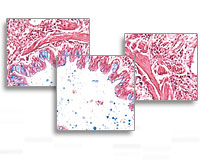
| | About Us | | Airways Diseases | | |||
| | |||||||
| |
Genetics and Pharmacogenetics of Airways Disease DBP Investigators Principal Investigator: Ross Lazarus MB.BS, MPH, GDipCompSci. Co-Principal Investigator: Scott T. Weiss MD, MS Current Status: Completed 2010
1. What questions did we ask in this DBP?
Background and Specific Aims: The biological problem that drives our proposal is the interplay between environmental exposures and genetic variation in determining both individual airways disease risk and individual response to airways disease medications. Asthma and chronic obstructive pulmonary disease (COPD) are common diseases of the airways, directly affecting 1 in 5 Americans and imposing a substantial economic burden, including health care costs of approximately 36 billion dollars per year(1). The high prevalence and serious health effects of these common diseases imply that improvements in treatment and prevention have the potential to make a dramatic impact. Tools and methods currently available were successful for monogenic disorders, but have not yielded major breakthroughs in complex diseases to date. The work we will perform as part of the Informatics for Integrating Biology and the Bedside (i2b2) project will lead to the development and implementation of methods and tools to improve genetic epidemiological and pharmacogenetic research in complex disease. 1. Develop and implement methods to detect distinct sub-phenotypes in asthma. We hypothesize that information gleaned from extensive, longitudinal clinical data collections will reveal subtle, previously unrecognized subgroups of patterns in the natural history and intermediate phenotypes of these diseases, potentially associated with underlying genetic variation, and that recognition of specific sub-phenotypes will prove to be of clinical, prognostic and pharmacogenomic importance in subsequent focused genetic studies and pharmacogenetic clinical trials. In collaboration with Cores 1, 2 and 4, we will develop and apply natural language processing, machine learning, classification and related data mining methods to large clinical databases, to search for and to catalog variants of these two clinical disease phenotypes.
We hypothesize that decreased phenotypic heterogeneity among cases will lead to greater statistical power to detect association. In collaboration with Cores 1, 2 and 4, we will apply and generalize the techniques and tools for identifying phenotypically homogenous subsets of patients developed in Specific Aim 1 for the identification of potential subjects suitable for recruitment into specifically targetted genetic and pharmacogenetic studies, while ensuring appropriate safeguards for patient privacy and medical record confidentiality.
We hypothesize that we can predict asthma exacerbations (hospitalizations and ER visits) with a combination of clinical and genetic variables.
We have developed genetic and non-genetic tests to predict asthma exacerbations and we will use the i2b2 asthma cases and controls to validate these newly developed predcitive tests. Update: · Using the Partners Healthcare Research Patient Data Registry (RPDR) of 4+M patients, we have identified a cohort of 97,000 asthmatic patients; records from these patients have been parsed for coded data and variables such as smoking history, comorbitdies, and medication history extracted by Natural Language Processing of unstructured text. · To enable identification of the subpopulation experiencing frequent exacerbation despite treatment with inhaled corticosteroids, we used data from a longitudinal clinical study of childhood asthma to build a predictive model for application to the RPDR cohort. Because the proportion of variance in asthma exacerbation risk was small, however, and many of the controlled variables measured in the clinical trial are not available from routine clinical records, we have concluded that extensive phenotypic data will not serve as useful predictors of exacerbations in this study. · Using hospitalization frequency as a measure of exacerbation, we have selected a cohort of 2,000 asthmatics assumed to be refractory to standard therapy (high service users) and 2,000 controlled asthmatics (low service users) for genome-wide association study to determine if the extreme subphenotype can be explained by genetic variation. · We are employing a novel system (“Crimson”) developed at the Pathology Department at Brigham and Women’s Hospital to collect anonymized, discarded blood samples from these patients for genome wide association study (funding applied for). This IRB compliant system is yielding thousands of samples a year. · Mining of the clinical data repository for phenotypic variables has driven development and refinement of the i2b2 Clinical Research Chart elements, including a comprehensive datamart, new visualization tools, and an NLP processing suite. · Dr. Lazarus has made significant progress in developing new tools for managing, analyzing and visualizing whole genome association data; these are freely available at http://bioconductor.org. Publications arising from this work:
| |||||
| | ||||
| | Home | Contact | Sitemap | Search | ©2026 i2b2 TranSMART Foundation | | |
| | | | | |

